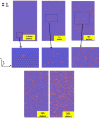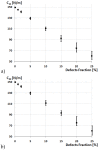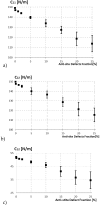Mechanical Properties of Monolayer MoS2 with Randomly Distributed Defects
- PMID: 32183101
- PMCID: PMC7142982
- DOI: 10.3390/ma13061307
Mechanical Properties of Monolayer MoS2 with Randomly Distributed Defects
Abstract
The variation of elastic constants stiffness coefficients with respect to different percentage ratios of defects in monolayer molybdenum disulfide (MLMoS2) is reported for a particular set of atomistic nanostructural characteristics. The common method suggested is to use conventional defects such as single vacancy or di vacancy, and the recent studies use stone-walled multiple defects for highlighting the differences in the mechanical and electronic properties of 2D materials. Modeling the size influence of monolayer MoS2 by generating defects which are randomly distributed for a different percentage from 0% to 25% is considered in the paper. In this work, the geometry of the monolayer MoS2 defects modeled as randomized over the domain are taken into account. For simulation, the molecular static method is adopted and study the effect of elastic stiffness parameters of the 2D MoS2 material. Our findings reveals that the expansion of defects concentration leads to a decrease in the elastic properties, the sheer decrease in the elastic properties is found at 25%. We also study the diffusion of Molybdenum (Mo) in Sulphur (S) layers of atoms within MoS2 with Mo antisite defects. The elastic constants dwindle in the case of antisite defects too, but when compared to pure defects, the reduction was to a smaller extent in monolayer MoS2. Nevertheless, the Mo diffusion in sulfur gets to be more and more isotropic with the increase in the defect concentrations and elastic stiffness decreases with antisite defects concentration up to 25%. The distribution of antisite defects plays a vital role in modulating Mo diffusion in sulfur. These results will be helpful and give insights in the design of 2D materials.
Keywords: defects; mechanical properties; molecular statics/dynamics; mono-layer MoS2; random distributed defects.
Conflict of interest statement
The authors declare no conflict of interest
Figures







References
-
- Kang M.A., Kim S.J., Song W., Chang S.J., Park C.Y., Myung S., Lim J., Lee S.S., An K.S. Fabrication of flexible optoelectronic devices based on MoS2/graphene hybrid patterns by a soft lithographic patterning method. Carbon. 2017;116:167–173. doi: 10.1016/j.carbon.2017.02.001. - DOI
Grants and funding
LinkOut - more resources
Full Text Sources

